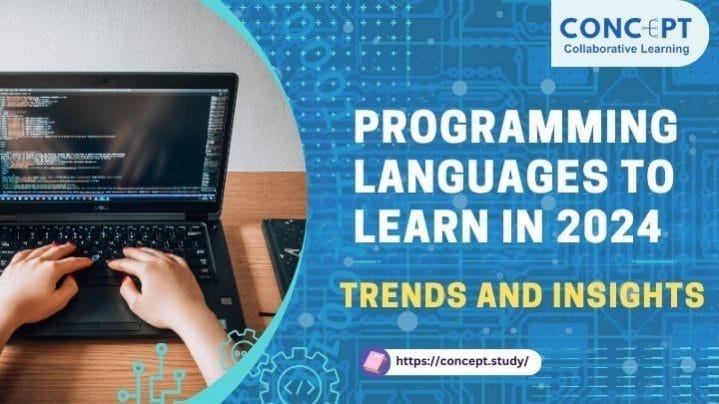
Top Programming Languages to Learn in 2024: Trends and Insights
As technology continues to evolve at a rapid pace, staying ahead in the programming world means keeping up with the latest languages and trends. Whether you’re a seasoned developer or just starting your coding journey, knowing which programming languages are in demand can help you make informed decisions about where to focus your efforts. Here’s a look at the top programming languages to learn in 2024, along with the trends and insights shaping their rise.
01. Python: The All-Rounder
Why Learn Python?
Python remains a top choice for many developers due to its simplicity and versatility. It’s widely used in web development, data science, artificial intelligence, machine learning, and more. Python’s extensive libraries and frameworks, such as Django for web development and TensorFlow for machine learning, make it an incredibly powerful tool.
Trends and Insights
- AI and Machine Learning: Python continues to dominate in AI and ML, thanks to libraries like TensorFlow, Keras, and PyTorch.
- Data Science: With tools like Pandas, NumPy, and Matplotlib, Python is the go-to language for data analysis and visualization.
- Beginner-Friendly: Its readable syntax makes Python ideal for beginners.
02. JavaScript: The Web Development King
Why Learn JavaScript?
JavaScript is essential for front-end web development and is increasingly used on the server side with Node.js. It enables the creation of dynamic, interactive websites and applications.
Trends and Insights
- Full-Stack Development: The rise of Node.js means JavaScript can be used for both front-end and back-end development.
- Frameworks and Libraries: React, Angular, and Vue.js are popular choices for building modern web applications.
- Growing Ecosystem: Continuous updates and vast community support ensure that JavaScript remains relevant.
03. Go (Golang): The Performance Powerhouse
Why Learn Go?
Developed by Google, Go is known for its efficiency and performance. It’s particularly popular for backend development, cloud services, and systems programming.
Trends and Insights
- Concurrency: Go’s built-in support for concurrent programming makes it ideal for scalable systems.
- Cloud Development: Widely used in cloud infrastructure projects, including Docker and Kubernetes.
- Simplicity: Go combines the performance of lower-level languages with the simplicity of higher-level languages.
04. Rust: The Safety and Performance Expert
Why Learn Rust?
Rust is renowned for its focus on safety and performance. It’s particularly valued for system-level programming and projects requiring high performance and security.
Trends and Insights
- Memory Safety: Rust’s strict compiler checks prevent many common bugs and security issues related to memory management.
- Growing Adoption: Increasingly used in areas like operating systems, game engines, and web assembly.
- Community Support: A passionate community and growing ecosystem are driving Rust’s adoption.
05. Kotlin: The Future of Android Development
Why Learn Kotlin?
Kotlin is officially supported by Google for Android development, making it a must-learn for mobile app developers. Its concise syntax and interoperability with Java have made it a favorite among developers.
Trends and Insights
- Android Development: Kotlin is now the preferred language for Android app development.
- Multiplatform Projects: Kotlin/Native allows for sharing code between mobile, web, and desktop applications.
- Corporate Backing: Strong support from JetBrains and Google ensures ongoing development and improvement.
06. Swift: The iOS Power Player
Why Learn Swift?
Swift, developed by Apple, is the language of choice for iOS, macOS, watchOS, and tvOS app development. Its modern syntax and performance optimizations make it a pleasure to work with.
Trends and Insights
- iOS Development: Essential for anyone looking to develop apps within the Apple ecosystem.
- Performance: Swift is designed to be fast and efficient, making it ideal for performance-critical applications.
- Community and Resources: A robust community and comprehensive resources make learning Swift accessible.
07. TypeScript: The Typed JavaScript
Why Learn TypeScript?
TypeScript is a superset of JavaScript that adds static types, making it easier to catch errors early in the development process. It’s widely adopted in large-scale web applications.
Trends and Insights
- Enterprise Adoption: Many large companies are adopting TypeScript for its scalability and maintainability.
- Framework Support: Excellent support in popular frameworks like Angular, React, and Vue.js.
- Developer Productivity: Enhanced tooling and error-checking improve developer productivity.
Conclusion
Choosing the right programming language to learn in 2024 depends on your career goals, interests, and the specific domains you wish to work in. Whether you’re drawn to the simplicity and versatility of Python, the web-centric nature of JavaScript, the performance of Go and Rust, or the specialized domains of Kotlin and Swift, there’s a language that can help you achieve your objectives. Let’s connect for the best and affordable Coding Classes in London
